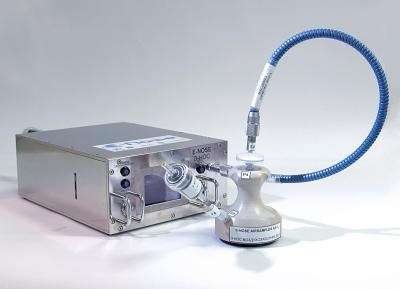Mon, Dec 17, 2012
Astrium Instrument To ‘Sniff Out’ Dangers To Health Of ISS Crew
When the next crew of the International Space Station (ISS) sets off into space aboard a Soyuz spacecraft on December 19, their luggage will contain an electronic nose developed by Astrium. This ‘E-Nose’, as it is called, will measure the crew’s exposure to bacteria and fungi in the Russian segment of the space station from 2013.

E-Nose will detect microbiological hazards from bacterial and fungal cultures using qualitative and quantitative methods. Monitoring is essential as excessive exposure to fungi and bacteria poses a not inconsiderable risk to both the on-board technology and the health of the crew. This specially developed analytical instrument allows cosmonauts to carry out measurements in every location of the ISS Service Module. Also in the luggage will be a ‘target book’ containing various material samples (aluminium, PCB material, cable marking material, and Nomex, a special flame-resistant clothing material which is used to make the suits worn by fire fighters and racing drivers). Biological cultures can colonize these materials. Their presence will be measured by the cosmonauts at two-month intervals. On completion of a measurement cycle lasting about six months, the target book will be sent back to Earth, where the samples will be evaluated by the Moscow-based Institute for Biological and Medical
Problems (IBMP) in cooperation with EADS Innovation Works, the corporate research organization of EADS.
The measurement system built by Astrium is called an electronic nose because it records specific odour patterns using ten different semiconductor sensors. The system takes advantage of the distinctive properties of the gas molecules emitted by the biological cultures. These molecules are produced by the metabolisms of the biological cultures, and are species-specific. Scientists in the laboratory down on Earth can create specific odour patterns based on the different ways in which individual sensors are stimulated. The data measured on the space station will then be compared against the data from the cultures ‘trained’ on Earth in order to find correlations.
The conventional sampling method (swipe sample) with subsequent ‘processing’ in an incubator would require expert knowledge and be very time-consuming in the ISS, whereas the new E-Nose enables a prompt analysis of the situation thanks to its data connection to the ground station.
“In the long run, the E-Nose will make an important contribution to ensuring the safety of the crew on board the ISS. This applies both to the entire space station and also to possible long-term missions (e.g. to Mars),” says Astrium project manager Thomas Hummel. There are also potential applications for the E-Nose down on Earth, e.g. on commercial passenger aircraft or submarines.
E-Nose is a German Aerospace Center (DLR) project, with Astrium as prime contractor.
(Image provided by Astrium)
More News
Aero Linx: International Business Aviation Council Ltd IBAC promotes the growth of business aviation, benefiting all sectors of the industry and all regions of the world. As a non->[...]
"During the annual inspection of the B-24 “Diamond Lil” this off-season, we made the determination that 'Lil' needs some new feathers. Due to weathering, the cloth-cove>[...]
Also: Bushcat Woes, Hummingbird 300 SL 4-Seat Heli Kit, Carbon Cub UL The newest Junkers is a faithful recreation that mates a 7-cylinder Verner radial engine to the airframe offer>[...]
Also: Seaplane Pilots Association, Rotax 916’s First Year, Gene Conrad After a decade and a half of struggling with the FAA and other aero-politics, G100UL is in production a>[...]
Also: Martha King Scholarship, Montaer Grows, Textron Updates Pistons, FlySto The FAA is hiring thousands of air traffic controllers, but the window to apply will only be open for >[...]
 ANN's Daily Aero-Linx (04.16.24)
ANN's Daily Aero-Linx (04.16.24) Aero-News: Quote of the Day (04.16.24)
Aero-News: Quote of the Day (04.16.24) Airborne 04.10.24: SnF24!, A50 Heritage Reveal, HeliCycle!, Montaer MC-01
Airborne 04.10.24: SnF24!, A50 Heritage Reveal, HeliCycle!, Montaer MC-01 Airborne 04.12.24: SnF24!, G100UL Is Here, Holy Micro, Plane Tags
Airborne 04.12.24: SnF24!, G100UL Is Here, Holy Micro, Plane Tags Airborne-Flight Training 04.17.24: Feds Need Controllers, Spirit Delay, Redbird
Airborne-Flight Training 04.17.24: Feds Need Controllers, Spirit Delay, Redbird



